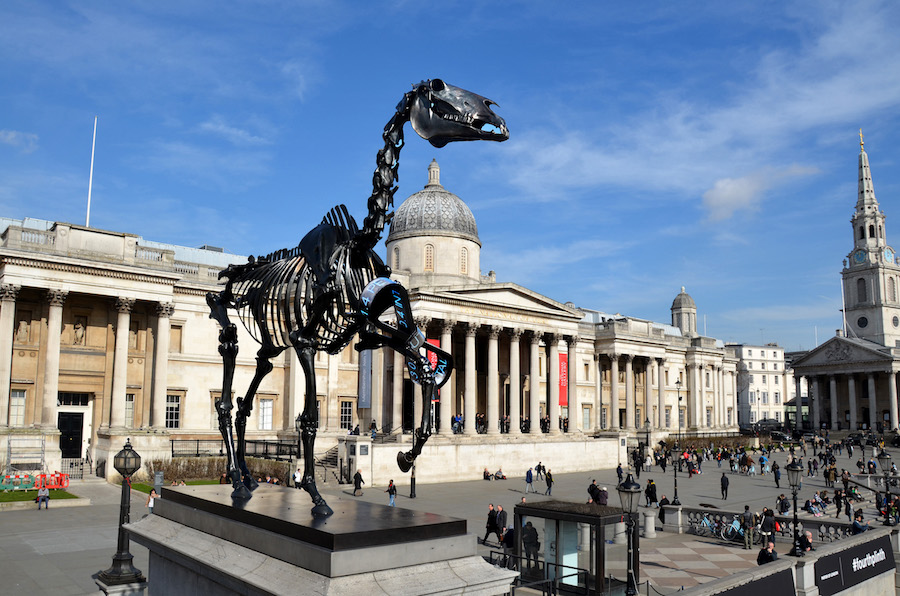Step aside, Sue the T. rex — another giant celebrity skeleton is coming to town.
Over the last two years, the Art Institute of Chicago has been planning to trot a major artwork into the city: Gift Horse (2014) by the artist Hans Haacke. The massive sculpture, originally unveiled in London's Trafalgar Square in 2015, depicts a horse in mid-stride, stripped down to its bones. Though it's not entirely bare: Around its lifted leg is a ribbon-shaped LED display that flashes stock exchange prices, transforming an otherwise pretty innocuous sculpture into a provocative statement on power and money.
Beginning October 5, the bronze work will stand outdoors in Chicago, on the Art Institute's third-floor Bluhm Family Terrace above the Modern Wing. Its appearance marks the first time that Gift Horse will be seen in North America.
Gift Horse, though, was essentially introduced to the world when it was first installed, given that Haacke created it for what is arguably the most famous public art commission on this planet. For the uninitiated, the Fourth Plinth awards international artists with the opportunity to adorn a vacant plinth in Trafalgar Square with one of their sculptures. (The prominent, highly coveted space was most recently handed over to a work by Chicago artist Michael Rakowitz.) Standing over 15 feet tall, Gift Horse towered over the site for a year and a half before moving to the Haus der Kunst in Munich in 2017. The Art Institute wanted to make sure its city was next.
"We felt it needed to come to Chicago," says Lekha Hileman Waitoller, an exhibition manager in the museum's Department of Modern and Contemporary Art. "It sparked our interest because it’s such a strong sculpture. There’s a lot to dig into in terms of its relationship to art, finance, and money, and also historical sculpture."
As Haacke, characteristically cagey about the meaning behind his horse, has put it: "What happens if the invisible hand of the market ties the knot for us?”
In London, Gift Horse's electronic ticker lit up with numbers from the London Stock Exchange; in Chicago, it will display market prices from the New York Stock Exchange, as collected in real time by a computer built into the sculpture's base. While Gift Horse, though, is very much grounded in the present, it is also rooted in art history. Haacke based his creature on etchings by the British painter and hippophile George Stubbs, and it also references the equestrian statue of William IV originally planned for the Trafalgar Square plinth in 1841 — which, notably, never materialized due to lack of funding.
Gift Horse will stand on a plinth at the Art Institute as well, to make it even more visible to people coming towards the museum from Millennium Park, which connects to the terrace via Nichols Bridgeway. The public nature of this plaza (which is free to visit) is one reason why the museum chose it as the site of Gift Horse, although it is not the easiest place to install a 4,000-pound sculpture.
"It's a massive undertaking, given that this is on a third-floor terrace that’s enclosed with glass," says Waitoller. "I have four contractors working on this. We have a 200-ton crane that will help lift this thing on in a couple of different parts, and it will be assembled. Every single aspect of this is logistically challenging."
The museum, of course, has raised large artworks to this space many times. The Bluhm Family Terrace hosts rotating installations; these have included a monumental bronze work by Ursula von Rydingsvard and Peter Fischli and David Weiss' plump snowman in a refrigerated vitrine.
Gift Horse is unique for another reason. Most of these terrace exhibitions remain on view for about five or six months, but Haacke's sculpture will rest outside the Art Institute for a much longer period — for 10 months, until July 14, 2019. This means Chicagoans will get to observe it against a backdrop of fall foliage, blanketed by the inevitable snowfall, and bathed in the light of spring.
Haacke's sculpture is coming to a city that sure loves a giant skeleton. Remember Felix, the massive skeleton of a cat installed in the atrium of the Museum of Contemporary Art last year? Maurizio Cattelan's sculpture was removed in April, but then we welcomed big boy Maximo the Titanosaur (Patagotitan mayorum) to the Field Museum in May. And although Sue was dismantled earlier this year, they are ever-present on Twitter. Gift Horse probably won't tweet, but you can bet on seeing it all over Instagram when it lands.



